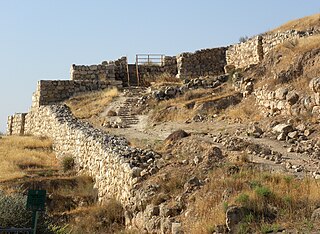Related Research Articles

The Tao Te Ching is a Chinese classic text written around 400 BC and traditionally credited to the sage Laozi. The text's authorship, date of composition and date of compilation are debated. The oldest excavated portion dates back to the late 4th century BC, but modern scholarship dates other parts of the text as having been written—or at least compiled—later than the earliest portions of the Zhuangzi.

Laozi also rendered as Lao Tzu, and Lao-Tze, was an ancient Chinese philosopher and writer. He is the reputed author of the Tao Te Ching, the founder of philosophical Taoism, and a deity in religious Taoism and traditional Chinese religions.

Lachish was an ancient Canaanite and Israelite city in the Shephelah region of Israel, mentioned several times in the Hebrew Bible. The current tell (ruin) by that name, known as Tel Lachish or Tell ed-Duweir ,, has been identified with the biblical Lachish. Today, it is an Israeli national park operated and maintained by the Israel Nature and Parks Authority. The park was established on lands of the depopulated Palestinian village of Qobebet Ibn ‘Awwad which was north of the Tel. It lies near the present-day moshav of Lakhish.
This article contains information about the literary events and publications of 1993.

The woolly rhinoceros is an extinct species of rhinoceros that was common throughout Europe and Asia during the Pleistocene epoch and survived until the end of the last glacial period. The woolly rhinoceros was a member of the Pleistocene megafauna.

The archaeology of Israel is the study of the archaeology of the present-day Israel, stretching from prehistory through three millennia of documented history. The ancient Land of Israel was a geographical bridge between the political and cultural centers of Mesopotamia and Egypt. Despite the importance of the country to three major religions, serious archaeological research only began in the 15th century. Although he never travelled to the Levant, or even left the Netherlands, the first major work on the antiquities of Israel is considered to be Adriaan Reland's Antiquitates Sacrae veterum Hebraeorum, published in 1708. Edward Robinson, an American theologian who visited the country in 1838, published its first topographical studies. Lady Hester Stanhope performed the first modern excavation at Ashkelon in 1815. A Frenchman, Louis Felicien de Saucy, embarked on early "modern" excavations in 1850. Today, in Israel, there are some 30,000 sites of antiquity, the vast majority of which have never been excavated.

Chu, or Ch'u in Wade–Giles romanization, was a Zhou dynasty vassal state. Their first ruler was King Wu of Chu in the early 8th century BCE. Chu was located in the south of the Zhou heartland and lasted during the Spring and Autumn period. At the end of the Warring States period it was destroyed by the Qin in 223 BCE during the Qin's wars of unification.
The year 1999 in archaeology involved some significant events.
The year 1996 in archaeology involved some significant events.

The Guodian Chu Slips were unearthed in 1993 in Tomb no. 1 of the Guodian tombs in Jingmen, Hubei Province and dated to the latter half of the Warring States period.
The year 1989 in archaeology involved some significant events.

Prehistoric Korea is the era of human existence in the Korean Peninsula for which written records do not exist. It nonetheless constitutes the greatest segment of the Korean past and is the major object of study in the disciplines of archaeology, geology, and palaeontology.

Eartham Pit is an internationally important archaeological site north-east of Boxgrove in West Sussex with findings that date to the Lower Palaeolithic. The oldest human remains in Britain have been discovered on the site, fossils of Homo heidelbergensis dating to 500,000 years ago. Boxgrove is also one of the oldest sites in Europe with direct evidence of hunting and butchering by early humans. Only part of the site is protected through designation, one area being a 9.8-hectare (24-acre) geological Site of Special Scientific Interest, as well as a Geological Conservation Review site.
Sarah Allan is an American paleographer and scholar of ancient China. She was a Burlington Northern Foundation Professor of Asian Studies in the Department of Asian and Middle Eastern Languages and Literatures at Dartmouth College; she is currently affiliated to the University of California, Berkeley. She is Chair for the Society for the Study of Early China and Editor of Early China. Previously, she was Senior Lecturer in Chinese at the School of Oriental and African Studies at the University of London. She is best known for her interdisciplinary approach to the mythological and philosophical systems of early Chinese civilization.
Boxgrove Man is a fossil thought to be of Homo heidelbergensis, an extinct relative of modern humans, and dated to roughly half a million years old. The fossil was discovered in 1993 in Boxgrove, West Sussex, near the south coast of England, by archaeologist Mark Roberts and his team of the Institute of Archeology at University College London. Only two pieces of the tibia (shinbone) and two teeth were found, so little is known about the characteristics of the human to whom the fossil belonged. It may be that this was a strongly-built woman, the gender cannot be determined and the species was robust in adaptation to the cold. The subject was about 40 years old, 1.8 m tall, and weighed roughly 14 stone. It is thought to be the oldest human fossil ever discovered in Britain.
This page lists major archaeological events of 2015.
Xing Zi Ming Chu, translated as Human Nature Is Brought Forth by Decree or The Inborn-Nature Comes from the Mandate, is a Warring States period text from the Kingdom of Chu, excavated in 1993 from the Guodian tomb, near Jingmen in Hubei, China. It is one of the earliest Chinese texts to discuss human nature, although it was lost until its re-discovery.
This page lists major archaeological events of 2018.
This page lists major events of 2019 in archaeology.
The Yana Rhinoceros Horn Site is an Upper Palaeolithic archaeological site located near the lower Yana river in northeastern Siberia, Russia, north of the Arctic Circle in the far west of Beringia. It was discovered in 2001, after thawing and erosion exposed animal bones and artifacts. The site features a well-preserved cultural layer due to the cold conditions, and includes hundreds of animal bones and ivory pieces and numerous artifacts, which are indicative of sustained settlement and a relatively high level of technological development. With an estimated age of around 32,000 calibrated years before present, the site provides the earliest archaeological evidence for human settlement in this region, or anywhere north of the Arctic Circle, where people survived extreme conditions and hunted a wide range of fauna before the onset of the Last Glacial Maximum. The Yana site is perhaps the earliest unambiguous evidence of mammoth hunting by humans.
References
- ↑ Nasti, Atilio (2001). "HMS Agamemnon" (PDF). Retrieved 2021-02-21.
- ↑ "From Israeli Site, News of House of David". The New York Times . 1993-06-08. Retrieved 2017-05-11.
- ↑ "Laozi". Stanford Encyclopedia of Philosophy . Stanford University.
- ↑ "The evolution of man". Science & Nature. BBC. Retrieved 2018-01-30.
- ↑ "Aracheology: Boxgrove Man reveals his Stone Age-old secrets" . The Independent . London. 1994-06-22. Archived from the original on 2022-05-01. Retrieved 2018-01-30.